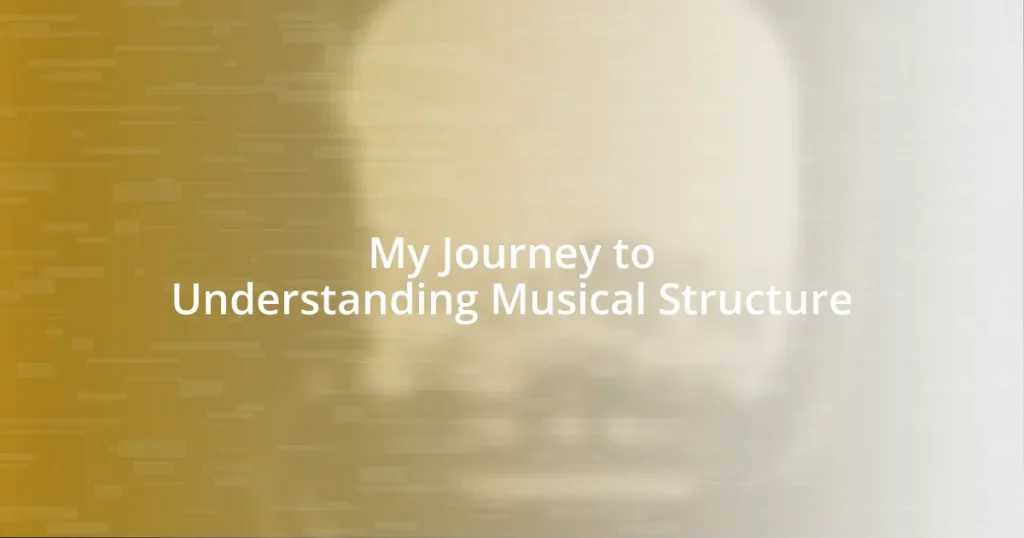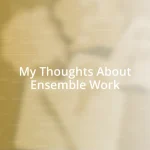Key takeaways:
- Understanding musical structure enhances appreciation of music, revealing how composers convey emotions through distinct sections like verses, choruses, and bridges.
- Key components such as rhythm, harmony, and transitions play critical roles in shaping listener experiences, making clever use of repetition and contrast essential for memorable pieces.
- Exploring various music genres highlights unique structural elements and emotional impacts, encouraging creativity and experimentation in personal compositions.

Understanding Musical Structure
Understanding musical structure is like discovering the blueprint of a beautiful building. I remember the first time I analyzed a song and realized that every section—be it verses, choruses, or bridges—served a distinct purpose. It made me wonder, how did composers decide on these formats?
As I delved deeper into my exploration, I uncovered how different genres employ varied structures. For instance, when I listened to a classical symphony, I noticed the intricate layering of themes and motifs. It struck me that much like storytelling, music has a beginning, middle, and end, each part connecting to evoke specific emotions. Isn’t it fascinating how a simple chord progression can convey both joy and sadness?
One of my favorite examples of musical structure is the use of a recurring motif, such as in Beethoven’s works. Every time that recognizable theme came back, I felt a profound sense of familiarity and anticipation. This repetition not only reinforces the emotional core of a piece but also invites listeners on a journey of exploration and rediscovery. How does understanding these structures change the way we experience music? For me, it’s transformed each listening session into an intimate dialogue with the composer.

The Basics of Music Theory
When I first started learning music theory, I was surprised to discover that it’s not just about notes and rhythms. It’s about understanding the language of music, breaking it down into manageable parts. This foundation really helped me appreciate the music I loved, allowing me to see how composers build their pieces like craftsmen.
Here are some basic concepts that form the groundwork of music theory:
- Notes: The building blocks of music, representing pitches.
- Rhythm: How notes are organized over time, giving music its movement.
- Scales: Collections of notes that form the basis for melodies and harmonies.
- Chords: Groups of notes played together, creating harmony.
- Intervals: The distance between two notes, essential for melody.
- Key Signature: Indicates the scale used, guiding the tonality.
Once I grasped these concepts, I felt a tangible thrill each time I listened to music, almost like having a secret map that revealed hidden paths. Understanding how these elements work together made me realize that every song tells a story. Whether it’s the heart-pounding beat of a pop anthem or the sweeping harmonies of a film score, each piece articulates emotions that resonate deep within us. Who knew music could be such a rich tapestry of emotions and connections?

Components of Musical Form
Components of musical form play an essential role in shaping how we perceive and enjoy music. When I started dissecting songs, I realized that every musical segment—like the introduction, exposition, and resolution—has its own function, much like chapters in a book. For example, the introduction sets the stage and builds anticipation, while the resolution brings a satisfying conclusion to the musical narrative. I often think about how these components come together; they offer us a structure that holds the emotional weight of the piece.
One of the standout components I encountered is the refrain or chorus. It’s the part that tends to stick in your mind, almost like an earworm. I remember listening to a pop song on repeat, fascinated by how the catchy chorus contrasted with the verses, which contained deeper storytelling. This deliberate choice in structure not only emphasizes the song’s central message but also engages listeners in a way that they remember it long after the song ends. Isn’t that magical?
Additionally, the role of transitions in musical compositions cannot be underestimated. I find that how one section flows seamlessly into another can deeply affect the listener’s experience. For instance, in a jazz piece I once listened to, the transition between solos felt so organic and fluid that it took me on an emotional roller-coaster ride. It’s moments like these that illuminate the intricate craft of musical form, making each listening experience richer and more profound, as if I were exploring an intricate maze of sound.
| Component | Description |
|---|---|
| Introduction | Sets the stage, creating anticipation for what follows. |
| Chorus | A repeated section that encapsulates the main idea, often making it memorable. |
| Verse | Provides narrative detail and develops the story or themes. |
| Bridge | Offers contrast, adding variety and depth to the composition. |
| Conclusion | Wraps up the piece, providing closure and reflection. |

Analyzing Popular Musical Pieces
When I dive into analyzing popular musical pieces, I often find myself captivated by how rhythm takes on a life of its own. Take a song like “Uptown Funk” by Mark Ronson featuring Bruno Mars; the infectious groove grabs you right from the start. I remember the first time I heard that track—I couldn’t help but move. The syncopation in the drum patterns and the bassline creates such a dynamic pulse, reinforcing how rhythm can elevate a simple melody into something extraordinary. Isn’t it interesting how one element can so profoundly change our emotional response?
As I analyze pop songs, I often notice the clever use of repetition. In Taylor Swift’s “Shake It Off,” the repetitive phrases in the chorus are designed to stick in your mind. I recall humming the chorus throughout my day, and it made me think about the power of familiarity in music. It’s fascinating how this repetitive structure engages us, making the song feel like a conversation we can easily join. Doesn’t it remind you of those catchy jingles that just won’t leave your head?
Harmonies also play a pivotal role in conveying emotion. The way John Legend layers his vocals in “All of Me” creates an intimate atmosphere that resonates deeply with listeners. I still remember listening to that song during a quiet moment and feeling the surge of love and vulnerability in the harmonies. By understanding how these layers work together, I’ve realized that musical analysis isn’t just about dissecting sounds; it’s about tapping into the core emotions that the composer wanted to communicate. How amazing is it that music can articulate such profound feelings without saying a single word?

Techniques for Creating Musical Structure
Developing a strong musical structure involves various techniques that can enrich the listening experience. One of my favorite approaches is employing contrast through a bridge. The first time I encountered a bridge in a song, it felt like stepping into an entirely different world. For instance, in “Bohemian Rhapsody” by Queen, the shift from the ballad to operatic section took my breath away. It taught me that contrasting segments can highlight different emotional states, creating a deeper connection with the audience.
Repetition is another powerful technique that I often utilize in my own compositions. When I wrote a song with a recurring motif, I noticed how it created a sense of familiarity and comfort. I remember performing it for friends, and their faces lit up as they recognized the repeating theme. It struck me then how repetition can build an emotional anchor in a piece, almost like a comforting hug, inviting listeners to engage with the music more intimately.
Additionally, varying dynamics throughout a piece can dramatically influence its structure. I once attended a concert where the artist played with soft verses that suddenly exploded into loud choruses. That contrast left me on the edge of my seat, fully immersed in the experience. It made me realize that playing with volume and intensity isn’t just about sound; it’s about crafting a narrative that draws people in and keeps them invested in the musical journey. Isn’t it remarkable how these techniques can transform a simple song into an unforgettable experience?

Exploring Various Musical Genres
Exploring various musical genres opens up a world of unique structures and elements that resonate differently with each of us. For example, when I first listened to jazz, the improvisational nature deeply intrigued me. I recall attending a live jazz performance that felt like a conversation between the musicians, each playing off the other’s ideas. The freedom within their structure was captivating—it made me wonder, how does music allow for such spontaneous expression while still maintaining cohesion?
In contrast, delving into classical music teaches me about intricate forms and development. I remember getting lost in Beethoven’s symphonies, particularly the way he builds tension through thematic variations. There’s something profoundly satisfying about the way a simple motif evolves, transforming from a whisper to a grand crescendo. It raises the question: how does this evolution mirror the complexities of life itself?
Rock music, on the other hand, often adheres to more straightforward structures, but the emotional impact can be enormous. I can still feel the adrenaline rush when hearing the opening chords of “Sweet Child O’ Mine” by Guns N’ Roses. That iconic guitar riff pulls you in, almost demanding your attention. It makes me ponder the effectiveness of simplicity in a genre that embodies rebellion, as sometimes it’s the straightforward arrangements that invoke the strongest feelings. Isn’t it fascinating how diverse genres can teach us different aspects of musical structure while evoking distinct emotions?

Applying Music Structure in Composition
When it comes to applying music structure in my compositions, one technique that resonates with me is the use of thematic development. I remember the first time I crafted a melody that evolved throughout the piece, shifting nuances while maintaining its essence. It felt as if I was taking listeners on a journey, where each note told a story of its own. Have you ever noticed how a simple idea can morph into something extraordinary with the right structure?
Another aspect I find compelling is the intentional placement of silence within a composition. There was an occasion when I decided to leave a brief pause before a powerful chorus. The moment was electric, and I felt the audience collectively holding their breath. It’s fascinating to consider: how can something as unassuming as silence create such profound anticipation and emotional release?
Lastly, exploring different time signatures has profoundly shaped my work. I once experimented with a song in 5/4 time, inspired by the unusual rhythms of some fusion artists. The challenge was exhilarating, and I noticed how it altered the flow of the piece, making the listener more engaged. Sometimes, breaking away from conventional structures opens up new avenues of creativity—could this be the secret ingredient to crafting memorable music?















